7 pricing models – and which you should choose
How to establish the right pricing model for your services.
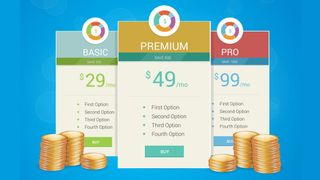
Pricing your creative and design services effectively is a difficult business. After you have calculated your shop rate, you have a baseline number for all of your pricing calculations. Using this number, you can determine what it takes to complete a project. To do so, you'll use one of seven different pricing methods.
Whether you're a freelancer or large agency, there is no single 'right way' to price your services. Instead, look for the 'ideal way' to price. Most companies will use two or three different methods.
- Exclusive offer: Save 15% on Adobe Creative Cloud now
Use your past experience and estimation exercises to determine how much time and effort is required for each project. Look at two or three models to find the right one for each situation. And since your minimum profit is already covered by your shop rate, you have much greater freedom to say no to bad pricing situations.
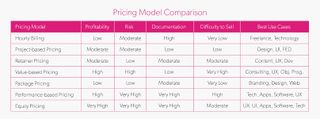
01. Hourly pricing
Hourly pricing is one of the two most simple models. The key things you need for successful hourly pricing is discipline, documentation and communication. It requires greater scrutiny of the process, which often doesn't foster client trust. Hourly pricing only works when you have good data. You must meticulously track your time and expenses, and consistently check in with your client.
This approach is ideal for freelancers who aren't directly working with the client – for example, a freelancer for an ad agency. It's also ideal for any work involving sophisticated technology such as app development, where things often go wrong. However, it isn't a long-term solution for most creatives unless you choose to remain freelance. You will only become more profitable by raising your rates, which has a ceiling.
To summarise, hourly pricing is a good option if:
- You're working regularly with the same client, on similar work
- The project's deliverables are unclear
- Project scope changed several times when meeting with the client
- You're doing complex technical work
02. Project-based pricing
The second of these simple models is project-based pricing, which can be used in tandem with the hourly model.
Project-based or 'flat-fee' pricing is the most common model. Someone asks you how much a website costs, you tell them $4,000, and you charge them $4,000 regardless of the time or cost involved. However, with this method we often underestimate the effort required, and end up with excessive changes or unexpected problems. This means a loss in profit or an awkward request for a budget increase.
Project-based pricing can be profitable, and it's a step toward value-based pricing and higher profit levels. If you do similar work for similar clients routinely (e.g. WordPress websites for restaurants), you can cut costs and increase profit with this approach. It can also work well if you're good at time estimates, but most of us aren't.
You want to use this approach if:
- The client asks about money a lot up-front
- It's clear you can get the project done faster than the client's estimate
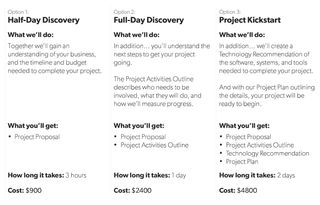
03. Retainer pricing
A retainer is the closest thing to a regular paycheck; it's a pre-set and pre-billed fee for a time period or volume of work. This can be based on time – for example the client agrees to buy 100 hours per month at $100 per hour, for a total of $10,000. Alternatively, it can be based on value. In this case the client might specify the features or deliverables they need, and pay $10,000 per month for this work, regardless of exactly how long it takes.
There are two types of time-based retainers: rolling and use-it-or-lose-it. In a rolling retainer, clients roll over any unused hours to the next month. In a use-it-or-lose-it retainer, any unused time is lost and the balance resets the next month. Don't offer rolling retainers; you'll end up doing meaningless work just so your client can burn through the hours.
You will find a maximum hourly rate a client is willing to pay. Value-based retainers enable you to scale your skills instead of your time, which means you can increase your profit. If you can reduce the time it takes to produce a chunk of code, you are no longer penalised for the increased efficiency. You are paid the same amount regardless of how long the job takes.
04. Value-based pricing
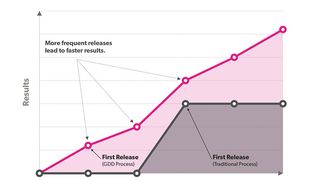
The crux of value-based pricing is ensuring the client is satisfied they paid for what they received. Two clients may pay a different price for the same work. But they aren't paying you for your time; they're paying you for solutions. And those solutions are worth more to some clients than others. It's driven by customer demand and their willingness to pay. The strategy is based on three components, which we'll look at now.
What your market will bear
Consider the limits of both your local market (where you do business) and your horizontal market (what you do). You can get granular and define your market as 'custom logo designs for consumer brands'. You need to find out what your competition is charging for similar work with clients of similar size. So how do you do this?
- Ask: You'll be shocked at how many people will tell you
- Go where the clients are: Instead of networking with other creatives, go to client events and trade shows and ask them what they paid
- Get involved: Go to conferences, join trade associations, and sit in round tables and talk about pricing
- Monitor: Set up alerts for freelance pricing guides and pricing surveys
Your track record
Your past experience will affect how much you can charge. If you have extensive experience with a particular type of client, technology or style of design, then you fall into the 'expert' category. Experts can charge more for their services. Clients see that hiring you means that they're more likely to get desirable results.
Perceived value
Often you'll be called upon to detail how your work is 'worth more' to the client than the work of others. There are ways to quantify value, but the mentality has to change from what the client values to the client valuing you and your expertise. This means you have to demonstrate expertise, competence, and the ability to quickly understand their problems.
05. Package pricing
Package pricing can get a business up and running, but it can also result in your services being viewed as a commodity. Putting your prices out front before you've analysed the client's problem puts your needs (money) above theirs (effective solutions).
You've removed the ability to find pain points and address them directly because you have fit their problem into your process. If your package pricing includes discovery and analysis, that won't be as big an issue.
Here are some examples of different package pricing options:
- Brand package: A logo, website and business cards at one fixed price
- Template customisation: Customised website themes for WordPress
- Consulting workshops and day rates: Aimed at public or private audiences
- Analysis or reviews: Analysis of existing projects at a fixed cost, including a report
- Photoshoots and videos: A certain number of shots or amount of time
You can also offer price ranges (for example, 'CMS-based websites range from $5,000 to $20,000'), or consider minimum project costs. 'Projects start at $10,000' indicates you will not accept projects that are less than $10,000.
06. Performance-based pricing
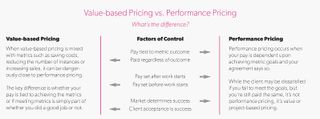
Performance-based pricing means to base your fee on the performance of your work. You must affect a measurable outcome for your client, such as higher revenue or increased efficiency. It's often tied to analytics, so it's common with web or application design, and with ad agencies and SEO experts that can measure media impressions.
You must have a bulletproof contract with clear metrics and clear terms – if you don't have legal support, don't use this model. It can result in powerful working relationships that closely align the buyer's goals and the seller's goals, creating the ultimate bond between you and your client. It's near-impossible to under-price yourself, as long as your metrics line up.
07. Equity pricing
You may be offered a stake in a business in exchange for your work, either in lieu of any cash payment or as a mix of equity and a reduced cash payment. This approach is good for side projects or small engagements, but not if you're giving up a large number of cash bookings or clients and you need the money now.
Success depends on where the company is at the time you get involved. If it hasn't received any outside funding, your ownership could be diluted once it does. If it has, you're going to be offered little equity, probably less than 5 per cent. If the company is funded but can't offer you partial cash, it's not worth it unless you plan to go and work there full-time.
Summary
Money can be messy, but it doesn't have to be. The key is to avoid getting emotional about pricing. No two projects or clients are the same, and there has to be a method to the madness. The sooner you get control of your pricing strategy, the sooner you'll find profitability.
Related articles:

Thank you for reading 5 articles this month* Join now for unlimited access
Enjoy your first month for just £1 / $1 / €1
*Read 5 free articles per month without a subscription

Join now for unlimited access
Try first month for just £1 / $1 / €1
Get the Creative Bloq Newsletter
Daily design news, reviews, how-tos and more, as picked by the editors.
Related articles
-

-

-

-

